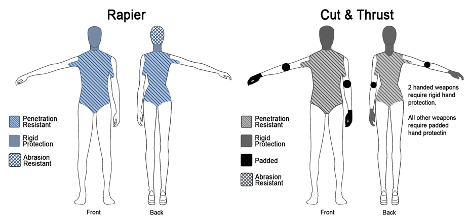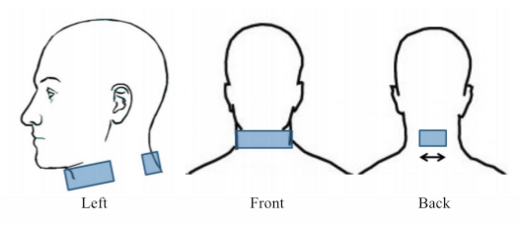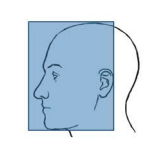Fencing:Armor Requirements
Jump to navigation
Jump to search
Armor Requirements
- Four types of armor are defined. These are Rigid, Penetration Resistant,Padded, and Abrasion Resistant.
- Figure 3 provides a summary of the types of armor and which body parts they cover.

Figure 3. Schematic of the body and minimum required protection. Note that some areas may require rigid protection, depending on the combatant's physiology.
- Figure 3 provides a summary of the types of armor and which body parts they cover.
- Limbs
- Limbs may be covered by abrasion resistant material if the fighter prefers but is not required.
- Exceptions
- The inner arm down to 4 inches (10 cm) below the armpit, are to be covered by penetration resistant material.
- The groin must be covered with penetration resistant armor.
- The armor as worn must cover these areas regardless of the fighter's position (standing, prone or on the ground).
- Light rapier - limbs must be covered by abrasion resistant material.
- Additional limb requirements for Cut and Thrust Combat
- Limbs must be covered by abrasion resistant material.
- Elbows must be protected by a minimum of a resilient padding at least 1/8 inch (12 mm) thick.
- The backs of the hands, including fingers and 1 inch (2.5cm) above the bend of the wrist must be covered by 1/4 inch(6 mm) open cell foam or equivalent resilient padding.
- If at least one combatant is using a two-handed metal weapon in Cut & Thrust Combat, then the backs of the hands, including fingers, and 1 inch (2.5cm) above the bend of the wrist on the back half of the forearm must be covered by rigid protection with sufficient coverage to prevent a reasonable percussive blow from contacting the bones of the hand and wrist.
- The rigid protection does not require padding underneath.
- The coverage for rigid protection may be achieved by any combination of gauntlet, sword guard, or defensive object. A shield alone may be considered an equivalent to full hand and wrist protection only if no part of the gloved hand or wrist is within 4 inches (10 cm) of the edge of the shield while the shield is in use.
- The torso, including the abdomen down to and including the groin in front, and the inner arm down to 4 inches (10 cm) below the armpit, are to be covered by penetration resistant material.
- The neck, including the front, sides, and back of the neck, is to be covered by penetration resistant material for Light Rapier Combat. The entire front 180 degrees of the neck, as well as at least 5 inches (12.5cm) centered on the cervical vertebrae, must be covered by rigid material for all other categories of Fencing (Figure 4).

Figure 4. The parts of the neck shown here shaded must be covered by rigid protection for all categories of Fencing except for Light Rapier Combat. The double headed arrow indicates that the neck, to a total width of 5 inches (12.5cm) centered on the vertebrae, must be covered. - The face and sides of the head up to and including a vertical line drawn at the back of the external ear are to be covered by a 12kg fencing mask or equivalent head protection (Figure 5). The mask must extend down past the chin such that the mask and gorget together do not present a significant section not covered by rigid protection from most reasonable thrusts coming from the front.

Figure 5. The head and face, indicated here, must be protected by a 12 kg mask or equivalent for Light Rapier and Rapier Combat; the rigid protection of a mask must be extended to the entire head for Cut & Thrust Combat to protect against percussive blows. - The metals listed in the glossary under rigid armor are considered equivalent to a 12 kg fencing mask mesh.
- Masks and helms must be secured to the fighter, so that they cannot be easily removed or dislodged during combat.
- All parts of a fencing mask or helm that might cause injurious contact with the wearer's head shall be padded or shall be suspended in such a way as to prevent contact with the wearer during combat. There shall be no major internal projections; minor projections of necessary structural components shall be padded. All metal shall be free of sharp edges.
- The interior of fencing masks must have a minimum of 1/4 inch (6 mm) open-cell foam or equivalent resilient padding to create separation between the mask and the wearer. Modern fencing masks (e.g. FIE and USFA type masks) in good working order meet this requirement without additional padding, but may require additional padding as it ages.
- For helms that utilize a suspension system which does not, on its own, prevent contact between the wearer and any rigid part of the helm, additional padding must be present. This padding must consist of at least 1/4 inch (6 mm) open-cell foam or equivalent resilient material.
- Helms without a suspension system and which rely on foam must use a minimum of 1/4 inch (6 mm) closed-cell foam or equivalent resilient padding which provides progressive resistance to create separation between the hard outer shell of the helm and the wearer.
- Similarly, parts of the inside of the helm that might come in contact with the wearer's neck or body must be padded.
- The rest of the head must be covered by abrasion resistant material for Rapier, and puncture resistant for Light Rapier. Rge rigid protection of a mask must be extened to the entire head for Cut & Thrust Combat to protect against percussive blows.
- The neck must be covered by rigid protection and Rapier Combat and Cut & Thrust Combat. The neck must be covered by at least penetration resistant material for Light Rapier.
- In addition, any part of the person vulnerable to significant serious injury or disproportionate bleeding, such as external reproductive organs, or hemangioma, must be covered by rigid protection.
- (Footnote: This list includes the face, however that is already required to be covered by rigid protection).
- Any body-worn medical equipment must also be covered in such a way that they are protected against blows or the possibility of the wearer falling on them.
- Armor is to be designed and worn so that no gaps form over vital body areas when the combatant assumes any reasonable position.
- Armor is to be inspected before each day's combat to check for any tears or signs of wearing. Penetration resistant armor is to be tested no less frequently than every two years using a drop tester, and may be tested at any time within that time frame at the marshal's discretion using the drop tester (see Appendix 3 for description of test). The exception to this testing is chain mail armor which meets the definition of penetration resistant. This type of armor must be inspected visually for any missing links. More than one adjacent missing link must be replaced before the armor is worn. Split rings with at least two full turns are acceptable replacement links.
- (Footnote:The drop test was created to help ensure that a broken blade, with the typical types of breaks seen, or an untipped blade, is less likely to pierce the opponent. No amount of armor will ever be perfect protection and is not meant as a replacement for comportment, training, and control.)
- (Footnote: Sweating and washing can wear out fabric, thinning it out and making it susceptible to penetration.)